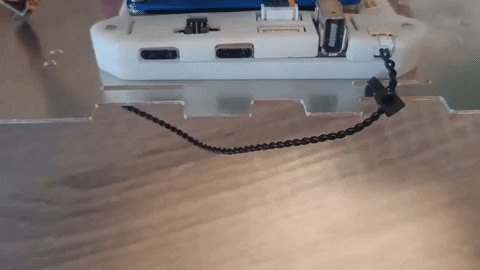Wiring Power cables
Introduction
There are two 5 pin JST-GH cables that provide battery power to the MR-CANHUBK344 and the NavQPlus. They are 5 pins, with no wire in the center position. Two wires are battery voltage+ and two wires are battery voltage-. Be sure to limit the voltage applied at the battery to <20V or the specified ratings for any boards plugged in.
The nominal battery voltage is expected to be ~12V,
Long and short power cable
There is one long and one short power cable included in the kit.
Connect is the LONG power cable from the MR-CANHUBK344 to one of the the Power Distribution Board Pout connectors.
The shorter length power cable can be similarly connected to the NavQPlus
When done, ZIP TIE the cables to the edge of the top plate and make them neat.
Wiring Power to MR-CANHUBK344
Power cable from PDB to MR-CANHUBK344

These cables connect to any of the 4 pin Pout connectors on the PDB. All Pout connectors are the same, but some may be closer and provide a better location. Choose one that makes your wiring tidy without overstretching the cable.

And the other end connects to the power input (AKA VBat) of the MR-CANHUBK344


Wiring Power to NavQPlus
Power Cable
Power cable from PDB to NavQPlus
It is a four-wire cable having two red and two black cables representing VCC and ground respectively. Firstly, connect one end of the cable to any of the pout terminal on the PDB.

Then connect the other end on the following connector of the NAVQPlus.

The cable shown below is NOT USED with the B3RB and PDB. It may be attached already when you first open the NavQPlus. Keep it safe as it may be useful for other configurations or when bench testing NavQPlus with an 3S LiPo battery or bench power supply.

BaseT1 Ethernet wiring between NavQPlus and MR-CANHUBK344
This is also explained here: PDB Wiring of RGB LED

Lidar connection
<TODO> refer to the mounting of the LIDAR base
The cable necessary for connect the NavQPus to the LIDAR-STL-27 is the number one in WITB Cables and Screws.
A closer view of this cable:

The Lidar used is the following:

You should connect the smaller end of the cable to the Lidar and the bigger end to the UART3 Serial port of the NavQPlus:

Thse are all the connections available for NavQPlus:
<TODO >
note on CAN
note on console
note on Ethernet